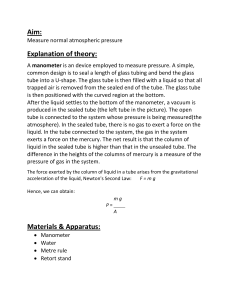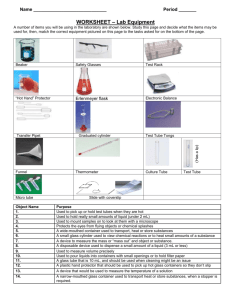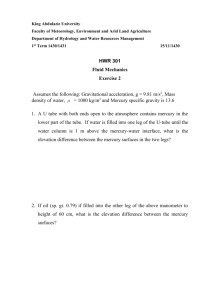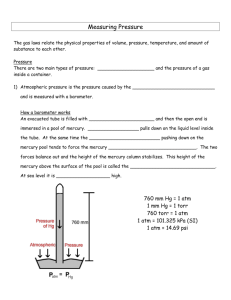Power Machines Pressure
advertisement
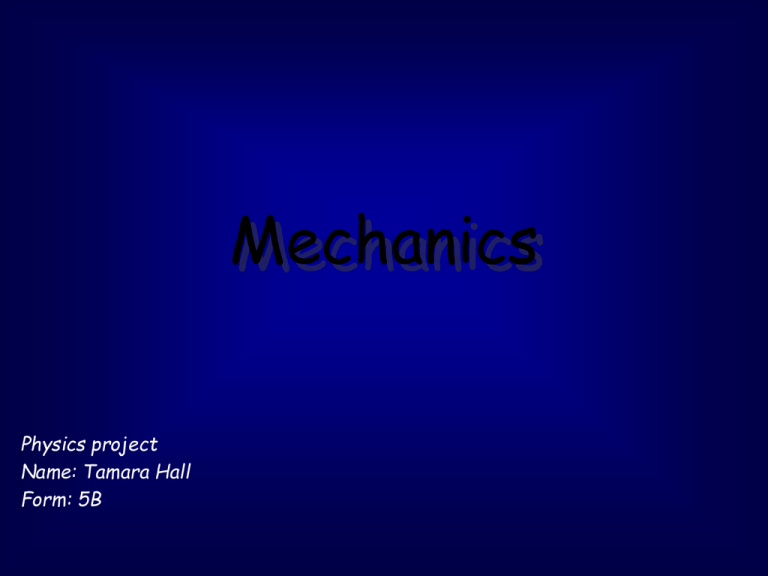
Mechanics Physics project Name: Tamara Hall Form: 5B Power • Power is the work done or energy converted per unit time. • P= E/t (where P-power, E- energy, t-time) • The unit for power is the Watt (W). Large amounts of power are measured in kilowatts (kW) or megawatts (MW). • 1W=1Js-1 i.e. 1 watt of power is dissipated if 1 joule of work is done or 1 joule of energy is transformed in 1 second. Friction • Friction is the force that opposes the relative motion of surfaces in contact and of bodies moving through fluids. • Friction increases with the roughness of the surfaces in contact. • Friction can be reduced by smoother surfaces, grease and other lubricants, rollers, wheels and ball bearings. • Whenever work is done against friction, heat is produced Diagram of a machine Machines • A machine is any device which enables a force to be applied at one point to overcome another. • The applied force is called the effort, E. • The force moved or overcome is known as the load, L. • There are many purposes for machines such as: i. multiplying forces ii. transferring energy Electrical energyan electrical motormechanical energy iii. Transferring energy from one place to another iv. Increasing speed v. changing the direction of a force vi. Multiplying distance • Examples of machines include levers, pully systems, bicycles and the forearm of humans. Efficiency of Machines • efficiency of a machine= energy input / energy output = work output/ work input = power output/ power input • Mechanical advantage is the ratio of the load moved to the effort applied • Velocity ratio is the ratio of the distance moved by the effort to the distance moved by the load. • % efficiency=mechanical advantage/velocity ratio x 100 • one factor which affect efficiency is friction. • Energy may be used more efficiently and economically in the Caribbean in forms such as: • Solar energy using solar water heaters. These produce abundant hot water and the cost is not too high. But they are not yet popular. Photovoltaic solar systems are getting close to the cost of generating electricity from fossil sources because of the intense sunlight and high cost of diesel. • Geothermal energy- Islands in the lesser Antilles are known to have potential for geothermal energy. Eg. Guadeloupe has a 4MW plant from shallow high temperature wells since 1984. Geothermal energy is capable of grid connection as relatively large amounts of energy can be generated from a single plant. • Natural gas- natural gas as a source of energy is important in Trinidad and Tobago currently eg. Petrotrin. However, with the large oil companies entering into electricity generation it is possible that gas could replace oil as an alternative energy source in the Caribbean. Hydrostatics Pressure • pressure is the force acting perpendicular to unit surface area. • The SI unit is Nm-2 and is called the Pascal • Pressure= force/area Pressure in fluids • pressure in fluids depend on depth below the surface and the density of the fluid. • Pressure at the same depth acts equally in all directions. • Pressure is uniformly transmitted through a liquid. One example of this application is the use of the hydraulic jack. A hydraulic jack is two cylinders connected. Among these two cylinders one is small and one is large. If a force is applied to the small cylinder it would result in a given pressure and this pressure would be the same in the larger cylinder. Since the larger cylinder has a greater area the force emitted by it would be greater. The pressure remains the same but there is a greater force. The Manometer A manometer is a device used to measure excess gas pressure. A simple design is to seal a length of glass tubing and then bend the glass tube into a U shape. It is then filled with mercury so all trapped air is removed from the sealed end of the tube. It is then positioned with the curved region at the bottom and the mercury settles at the bottom. After this occurs, a vacuum is produced in the sealed tube and the open tube is connected to the system whose pressure is being measured. In the sealed tube there is no gas to exert a force on the mercury. The net result is that the column of mercury in the left (sealed) tube is higher than that in the right (unsealed) tube. The difference in the heights of the columns of mercury is a measure of the pressure of gas in the system. A manometer Archimedes Principle • Archimedes principle states that when a body is fully or partially submerged in a fluid the upthrust equals the weight of the fluid displaced. • An object will float if the upthrust is greater than the weight of the object. Eg. A cork floating in water • An object will be partially submerged if the weight of the object equals the upthrust. Eg. Wood in water • An object will sink if the upthrust is less than the weight of the object. Eg. When water is pumped into the tanks of a submarine the weight becomes greater than the upthrust and it sinks

